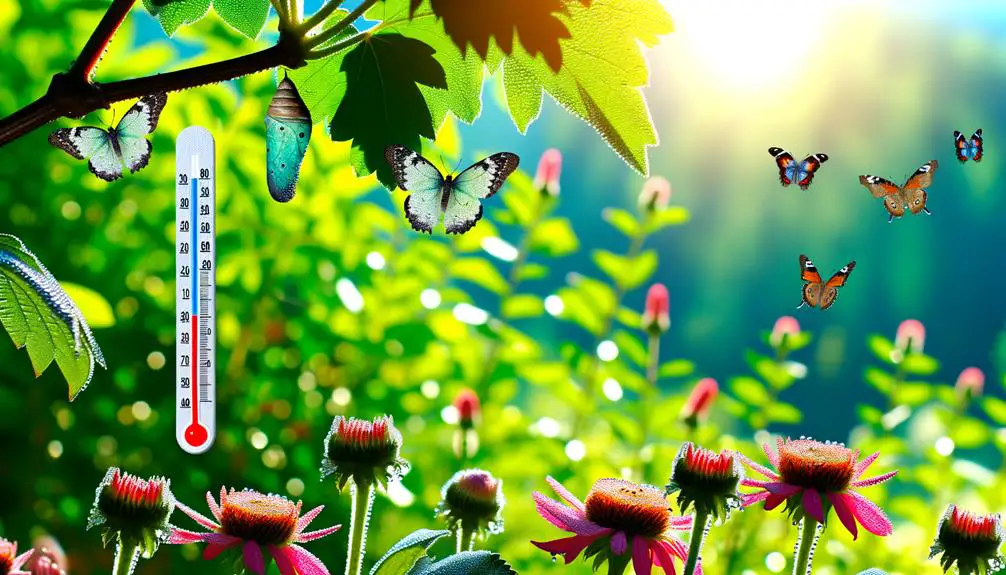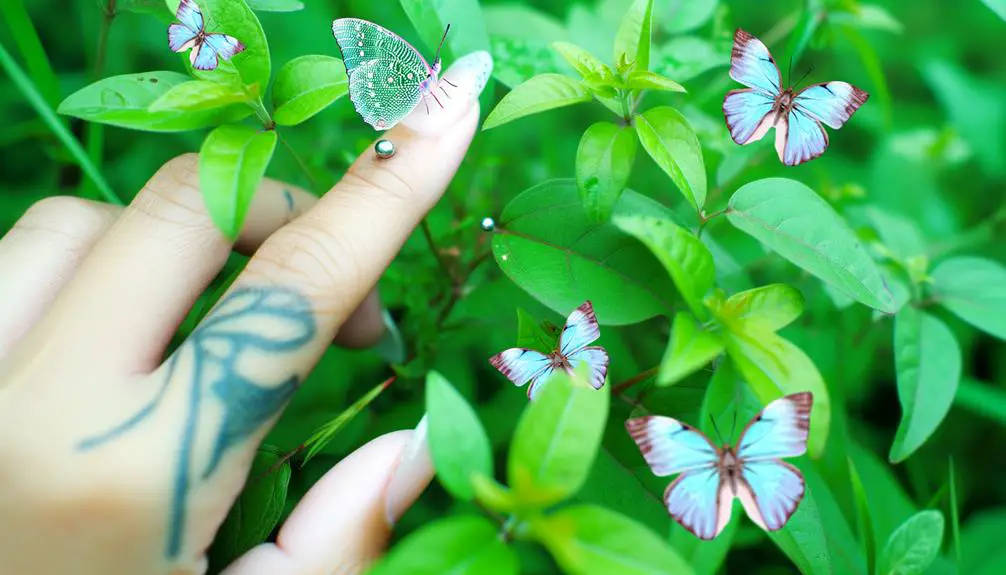7 Tips for Safely Releasing Butterflies After Hatching
Releasing butterflies after hatching should be done when temperatures are between 68°F and 86°F to optimize their metabolic and flight capabilities. Avoid releasing them during rainy conditions, as wet wings can impede flight and increase predation risk.
Ideal wind speeds are below 10 mph. Late morning to early afternoon is the best time, ensuring ambient temperatures around 70°F to 85°F.
Butterflies must exhibit strong, consistent flight and display effective feeding behavior before release. Late spring to early autumn provides the necessary nectar availability, aligning with natural behaviors and migration patterns essential for their survival.
Further insights on this topic await.

Key Takeaways
- Release butterflies in late morning to early afternoon when temperatures are between 70°F to 85°F.
- Ensure the weather is dry and wind speeds are below 10 mph to facilitate safe flight.
- Look for fully developed butterflies with dry, undamaged wings and strong flight ability.
- Choose late spring to early autumn for optimal temperatures and nectar-rich flower availability.
Ideal Temperature Range

Guaranteeing an ideal temperature range is essential for the successful release of newly hatched butterflies, as it greatly impacts their ability to acclimate and thrive in their natural environment.
The best temperature range for most butterfly species lies between 20°C to 30°C (68°F to 86°F). Temperatures below this range can slow down their metabolic processes and hinder their flight capabilities, while excessively high temperatures may cause dehydration and stress.
Monitoring local weather forecasts and utilizing a reliable thermometer can assist in determining the appropriate release time. Maintaining this temperature range guarantees that butterflies possess the requisite energy and physiological stability to commence feeding, mating, and dispersing, thereby enhancing their survival prospects in the wild.
Avoiding Rainy Conditions
Releasing butterflies in rainy conditions can greatly impair their ability to fly, as the moisture can weigh down their wings and hinder proper movement.
Additionally, rain increases vulnerability to predators and environmental hazards, reducing their chances of survival.
Consequently, it is essential to wait for dry weather to guarantee the ideal release of butterflies.
Impact on Butterfly Flight
Adverse weather conditions, particularly rain, can greatly impair butterfly flight by affecting their wing function and thermoregulation.
Rain can cause the following issues:
- Wing Damage: Raindrops can damage delicate butterfly wings, leading to tears and impairing their ability to fly.
- Thermoregulation Disruption: Butterflies rely on solar radiation to warm their flight muscles; rain and cloud cover can inhibit this process, reducing their ability to generate necessary flight energy.
- Weight Burden: Wet wings increase body weight, making takeoff and sustained flight difficult, potentially leading to increased predation risk.
Releasing butterflies during dry, sunny conditions guarantees they have the best environment for successful flight, contributing to their survival and ability to fulfill ecological roles.
Increased Vulnerability Factors
Avoiding the release of butterflies during rainy conditions is vital to mitigate increased vulnerability factors that could jeopardize their survival and ecological functionality. Rain can saturate their wings, preventing proper flight and reducing their ability to evade predators. Additionally, wet conditions can lead to hypothermia and increased predation, as butterflies are unable to seek shelter efficiently. The table below highlights key vulnerabilities associated with releasing butterflies in rainy conditions:
| Vulnerability Factor | Impact on Butterflies | Recommended Action |
|---|---|---|
| Wing Saturation | Inhibited Flight | Release in dry conditions |
| Hypothermia | Decreased Metabolism | guarantee warm, dry environment |
| Increased Predation | Reduced Evasion Capability | Release in predator-free areas |
| Limited Shelter Availability | Exposure to Elements | Provide artificial shelters |
Understanding these factors is vital for the effective release of butterflies.
Wind Speed Considerations

Wind speed plays a critical role in determining the ideal conditions for releasing newly hatched butterflies, as high winds can impede their ability to fly and increase the risk of injury. To optimize their survival, it is vital to take into account the following factors:
- Wind Speed Threshold: Butterflies should ideally be released when wind speeds are below 10 mph to guarantee they can control their flight and find shelter.
- Turbulence: Avoid releasing butterflies during gusty conditions, as sudden wind changes can disorient and harm them.
- Microclimate: Release butterflies in sheltered areas with natural windbreaks, such as gardens with dense foliage, to provide a safer environment.
Time of Day
Determining the ideal time of day for releasing butterflies involves understanding their behavioral patterns and environmental preferences to guarantee their successful acclimatization and survival.
Butterflies are ectothermic organisms, meaning their activity levels are heavily influenced by ambient temperatures. Releasing them during the late morning to early afternoon, when temperatures range between 70°F and 85°F, guarantees they are warm enough to become active quickly.
Additionally, these periods typically offer prime sunlight, which butterflies utilize for thermoregulation. Morning dew has evaporated by this time, reducing the risks of damp conditions that could hinder flight.
Avoiding late afternoon releases is also advisable as it provides butterflies adequate daylight hours to find nectar sources and establish themselves in their new environment.
Butterfly Readiness

Ensuring butterfly readiness for release involves careful observation of their physical condition and behavioral cues to ascertain their ability to thrive in a natural environment.
Key indicators include:
- Wing Condition: The wings should be fully expanded and dry, free from deformities or damage, ensuring successful flight.
- Flight Capability: The butterfly should demonstrate strong, consistent flight without signs of fatigue or disorientation, indicating robust musculature and coordination.
- Feeding Behavior: The butterfly must exhibit effective feeding behavior, such as extending its proboscis and successfully obtaining nectar, which is essential for energy and survival.
Seasonal Timing
Seasonal timing is a critical factor that greatly influences the survival and thriving of butterflies post-release, as it determines the availability of essential resources and suitable climatic conditions.
Ideal release periods are typically during late spring to early autumn when temperatures range between 55°F to 90°F. This period guarantees that nectar-rich flowers are abundant for feeding, and favorable weather conditions are present for flight and mating behaviors.
Additionally, releasing butterflies during these months aligns with their natural life cycles, maximizing reproductive success.
In regions with colder climates, late summer releases are preferable, allowing butterflies sufficient time to engage in migratory behaviors if necessary.
Careful consideration of local seasonal patterns is therefore paramount for successful butterfly release and population sustainability.
Predatory Threats

When planning the release of newly hatched butterflies, it is vital to take into account the presence of natural predators, such as birds, spiders, and ants, which can greatly affect survival rates.
Implementing habitat safety measures, such as choosing areas with ample foliage for hiding and avoiding regions with high predator activity, can enhance the chances of butterfly longevity.
Understanding these predatory threats and taking proactive steps to mitigate them is essential for ensuring a successful release.
Natural Predators Awareness
Understanding the various natural predators that butterflies face is essential for determining the ideal time for their release after hatching.
Predatory threats are numerous and can greatly impact butterfly survival rates. The key predators include:
- Birds: Many bird species are adept at catching butterflies, particularly during their initial flight stages.
- Spiders: Web-building spiders pose a constant threat, often capturing butterflies as they navigate through vegetation.
- Ants: These insects can attack and kill newly hatched butterflies, especially when they are still vulnerable and unable to fly proficiently.
Habitat Safety Measures
Implementing effective habitat safety measures is essential for minimizing the predatory threats that newly hatched butterflies encounter. Predators such as birds, spiders, and ants are significant threats to vulnerable butterflies.
To mitigate these risks, it is advisable to release butterflies in environments with dense vegetation, which can provide both camouflage and physical barriers. Additionally, ensuring the presence of nectar-rich plants like milkweed and butterfly bushes can help sustain butterflies while deterring predators.
Creating a habitat with diverse plant species can attract a variety of insects, potentially diluting the concentration of predators. Furthermore, avoid releasing butterflies during peak predator activity times, such as early morning or late afternoon, to further enhance their survival chances.
Suitable Release Locations
Selecting an appropriate release location for newly hatched butterflies is critical to guarantee their survival and integration into the local ecosystem. To verify the ideal environment, consider the following factors:
- Native Plant Availability: Choose areas with abundant native flowering plants and nectar sources that cater to the butterfly species' dietary needs.
- Predator Presence: Avoid locations with high concentrations of natural predators such as birds, spiders, and insectivorous mammals, which can greatly reduce butterfly populations.
- Microclimate Conditions: Select sites with suitable microclimates, including adequate sunlight, humidity, and shelter from strong winds, to support butterfly activity and thermoregulation.
These criteria verify that the butterflies have the resources needed to thrive and contribute to the local biodiversity.
Preparing for Release

Prior to releasing newly hatched butterflies, it is vital to confirm that they have fully developed and are capable of independent flight and survival. This involves closely monitoring the butterflies to verify their wings have completely dried and expanded after emerging from the chrysalis.
Ascertain they exhibit robust flying behaviors within an enclosed space. Additionally, providing a carbohydrate-rich diet, such as sugar water or nectar, is essential to supply the necessary energy for their initial flights.
The release area should be free of predators and adverse weather conditions, such as strong winds or heavy rain. Finally, choose a time of day when temperatures are moderate, ideally mid-morning, to optimize their chances of successful acclimatization and survival.
Post-Release Monitoring
Post-release monitoring is essential to evaluate the success of butterfly reintroduction into their natural habitat.
This includes tracking flight patterns to understand their dispersal range, observing behavior changes that may indicate adaptation or stress, and recording environmental interactions to guarantee they are integrating effectively with local flora and fauna.
Detailed data collection in these areas provides insights that can inform future conservation efforts.
Tracking Flight Patterns
Effective tracking of butterfly flight patterns post-release requires precise monitoring techniques and advanced technology to guarantee accurate data collection. Scientists employ various methods to study these patterns, ensuring robust and reliable data.
Key methodologies include:
- Radio Telemetry: This involves attaching miniature radio transmitters to butterflies, allowing researchers to track movements via signals received by directional antennas.
- GPS Tracking: Advanced GPS devices, though limited by size constraints, provide high-resolution spatial data on butterfly migration routes and habitat utilization.
- Mark-Recapture Studies: Marking butterflies with unique identifiers and subsequently recapturing them helps estimate population sizes and movement patterns.
These techniques collectively enhance our understanding of butterfly ecology, facilitating informed conservation strategies and contributing to broader ecological research.
Observing Behavior Changes
Understanding the nuances of butterfly behavior post-release necessitates meticulous observation and detailed documentation of their activities and interactions within their natural habitat.
Key behaviors to monitor include feeding patterns, mating rituals, and territorial movements. Observers should note changes in foraging efficiency and preferences for specific nectar sources, which indicate adaptation success.
Additionally, documenting courtship displays and subsequent mating can provide insights into reproductive health and population sustainability. Territoriality, marked by specific flight paths and resting sites, reveals how butterflies establish and defend their space.
Detailed behavioral records, when compared across different individuals and environments, can elucidate the factors influencing post-release survival and integration, thereby informing future conservation and reintroduction efforts with greater precision.
Recording Environmental Interactions
Systematic documentation of environmental interactions is essential for evaluating the adaptability and survival prospects of butterflies following their release.
Post-release monitoring involves detailed observation and data collection, focusing on various ecological parameters.
Key aspects to record include:
- Habitat Utilization: Track which types of vegetation and microhabitats the butterflies prefer. This can provide insights into their foraging and sheltering behaviors.
- Predator-Prey Interactions: Documenting encounters with predators helps in understanding the survival challenges the butterflies face. This includes noting the types and frequency of predatory threats.
- Weather Conditions: Regularly record temperature, humidity, and wind conditions, as these factors considerably influence butterfly activity and survival.
Ethical Considerations

Releasing butterflies post-hatching involves several ethical considerations, including guaranteeing the local ecosystem's balance is maintained and that the butterflies have a high chance of survival.
Introducing non-native species can disrupt local habitats, leading to unforeseen ecological consequences. Consequently, it is imperative to release butterflies in environments where they naturally occur.
Additionally, timing the release to coincide with the availability of nectar sources and suitable weather conditions increases their survival prospects.
Ethical practices also necessitate minimal human intervention, allowing butterflies to follow natural behaviors.
Moreover, it is essential to take into account the genetic diversity of the butterflies being released, avoiding the introduction of potentially harmful genetic traits.
Adhering to these guidelines guarantees responsible stewardship of both the butterflies and their habitats.
Conclusion
In summary, releasing butterflies necessitates careful consideration of the perfect temperature range, avoidance of rainy conditions, monitoring of wind speeds, and timing of the day. These factors ensure the butterflies have the best chance of survival and successful integration into their environment. Additionally, understanding how to attract butterflies can help create a welcoming habitat with nectar-rich flowers and suitable shelter. By providing these essential resources, you can support a thriving butterfly population in your area.
Ensuring butterfly readiness, selecting suitable release locations, and preparing meticulously for release are essential steps.
Post-release monitoring and adherence to ethical considerations further enhance the success of the process.
These parallel factors collectively contribute to the best integration of butterflies into their natural habitats, promoting ecological balance and conservation efforts.







маркетплейс аккаунтов покупка аккаунтов
площадка для продажи аккаунтов биржа аккаунтов
биржа аккаунтов площадка для продажи аккаунтов
купить аккаунт https://ploshadka-prodazha-akkauntov.ru/
маркетплейс аккаунтов купить аккаунт с прокачкой
маркетплейс для реселлеров аккаунт для рекламы
маркетплейс аккаунтов https://pokupka-akkauntov-online.ru
Sell accounts https://buyverifiedaccounts001.com/
Accounts market accountsmarketplacepro.com
Account Catalog Find Accounts for Sale
Accounts market Purchase Ready-Made Accounts
Secure Account Sales Buy Pre-made Account
Website for Selling Accounts Marketplace for Ready-Made Accounts
Accounts market Accounts marketplace
Profitable Account Sales Account Purchase
Accounts market Website for Selling Accounts
Sell accounts buyaccounts001.com
Account Selling Platform Verified Accounts for Sale
account market website for selling accounts
website for buying accounts account buying platform
ready-made accounts for sale purchase ready-made accounts
online account store account market
buy account account market
secure account sales buy account
account marketplace guaranteed accounts
gaming account marketplace account selling service
account selling platform profitable account sales
profitable account sales accounts market
account purchase ready-made accounts for sale
accounts marketplace account trading platform
account market account trading platform
buy account account trading platform
online account store database of accounts for sale
website for buying accounts ready-made accounts for sale
secure account purchasing platform accounts marketplace
buy pre-made account account acquisition
database of accounts for sale account buying platform
account trading buy account
accounts marketplace account selling platform
accounts market online account store
account buying platform accounts for sale
account exchange service account buying service